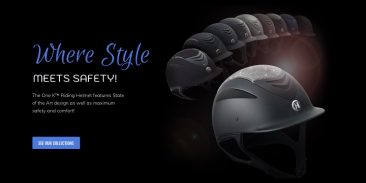“She had a helmet on, and she still got hurt,” the woman said. Well, sure. I take vitamins, and I’m still getting older.
If this is logic, then I’m missing the point. To be clear, I wasn’t born in a helmet. When I was a kid, we didn’t have tack, much fewer helmets. But I’m capable of change. Apparently, that’s a bigger deal than I think; the common reason I hear for not using a helmet is they never wore them in the past. I didn’t use a cell phone back then either. I changed.
When I’m able to talk helmets with a helmet-resistant rider quietly, they usually give the same reason. With a self-effacing smile, they admit the reason is probably ego. An uncomfortable silence follows. Sometimes I stare, wondering if ego is usually the thing that gets in the way of us caring about our loved ones.
In the past, I’ve ranted about freak accidents and logic. That’s silly, of course. All the statistics are undeniable. Everyone knows everything. Maybe I should be happy that kids think of helmets as part of their riding/superhero costume and just bite my tongue.
I can’t because I’m a horse advocate. I disagree with riders who think what’s on the outside of their head is more important than protecting what’s inside: their intellect, personality, and most important to their horse, the ability to buy hay. What does it mean to have concern for horse slaughter or the plight of the mustangs but take your own life for granted? Why not do all you can to be there for your horse (if not your loved ones)?
I can hear their defiant anti-helmet proclamation. Well, I’m not afraid to die on horseback either. What I’m afraid of is NOT dying. I couldn’t bear living without horses.
The new statistic that caught my eye this year is a study conducted by a team of Alberta researchers found that riders who reported an injury had an average of 27 years of riding experience. New riders had a relatively small incidence of injury.
It rings true for me. In my extended circle of riders, there were several injuries this past year. Some were quite serious. Some took place on the ground or at the mounting block. All the injured were experienced horse people with many years in the saddle.
I see a lot of complacency in the horse world. It’s a luxury I can’t afford as a professional. I must keep my focus at all times; I need to see the world with an equine range of vision. Training horses and riders requires awareness. I’m always surprised at the number of times I witness riders unaware of obviously dangerous situations. I’d call it a passive disrespect of their horses. Sometimes they don’t know better, even after a life with horses. Sometimes it’s laziness. And sometimes we just get bull-headed as we age, set in our ways and unwilling to grow or learn. I suppose there is a certain cosmic balance to getting a head injury from not using your head.
For me, I’m trained to see patterns in horse behaviors and human behaviors. When I see a rider defend their ego, or even just close their minds toward helmets, safety, and common knowledge, how does that reflect on their training methods? How does it reflect on their horses?
I understand how difficult it is to change. Looking back, horses have asked me to change everything about myself. I resisted; it was hard and once you start, the learning never ends. However, I still see horses through the eyes of that little horse-crazy girl. The rest of me has changed as horses have asked me to. Like most of us who have applied ourselves, I’m a better person for their equine input. It took another species to teach me humanity. If nothing else, I want to be around to enjoy that, sound in mind, for as long as I can.
I’ll finish this post with the usual list of important information, in hopes that it might make a difference to the people who can make a difference …
Stats and sources:
- Equestrians are 20x more likely to sustain an injury than a motorcycle rider.
- 60 – The number of deaths/year due to a head injury (compared with 8 for Football)
- 60% of riding fatalities occur from head injuries.
- 15,000 number of ER admissions for equine-related head injuries in 2009.
- 2 feet – The distance of a fall at which head injury can occur.
Head injuries have been found to be one of the most frequently occurring injuries and are the leading cause of death in horse-related injury events, according to a 2018 Swedish study. Other studies have shown that 45% of all TBI (traumatic brain injuries) are horse related. Riding is considered more dangerous than motorcycling or downhill skiing. And it’s not just while mounted. Approximately 20% of accidents, which result in head injury, happen while the person is on the ground. They are just as common in professionals as amateurs.
If you have a hard impact blow while wearing your helmet, immediately replace it with a new one. There may be damage to the helmet that is not visible to the naked eye. Helmet manufacturers generally recommend replacing your helmet every four to five years.
There is no statistical correlation between skill level and injury likelihood. Professional riders are just as at risk to sustain an injury due to a fall as less frequent riders. Head injuries are cumulative. An original head injury can be made much worse by additional concussions. Your injury risk depends on the height from which fall, as well as the speed at which you’re traveling. Even a fall from a standing horse can be catastrophic.
-Anna Blake





